Burgeson Family Farm has new owners
We are happy to update our customers with the good news that our farm has been sold to an energetic couple who are excited to keep the tradition going. So soon, our farm will have a new name, and the personal touches of the new stewards, but the fabulous soil, water, and growing conditions of this unique piece of property will guarantee the success of their farming future. Allow the new owners time to get up and running, and keep in touch, and we will update you on this site as to their progress. But rest assured that the farm is in good hands, and we will keep you informed on this site so you will know when once again you can enjoy produce from the farm.
End of an era for Burgeson Family Farm
34 years ago, an energetic young couple found an empty hilltop, covered with thistle, and barren of all but one lonely oak tree. From the top of the hill, they could see for miles, and a shovel easily turned over the sandy loam and decomposed granite soil. They decided that this was the place to build a home, create a life and a family, and to pursue a dream, and Burgeson Family Farm was born.



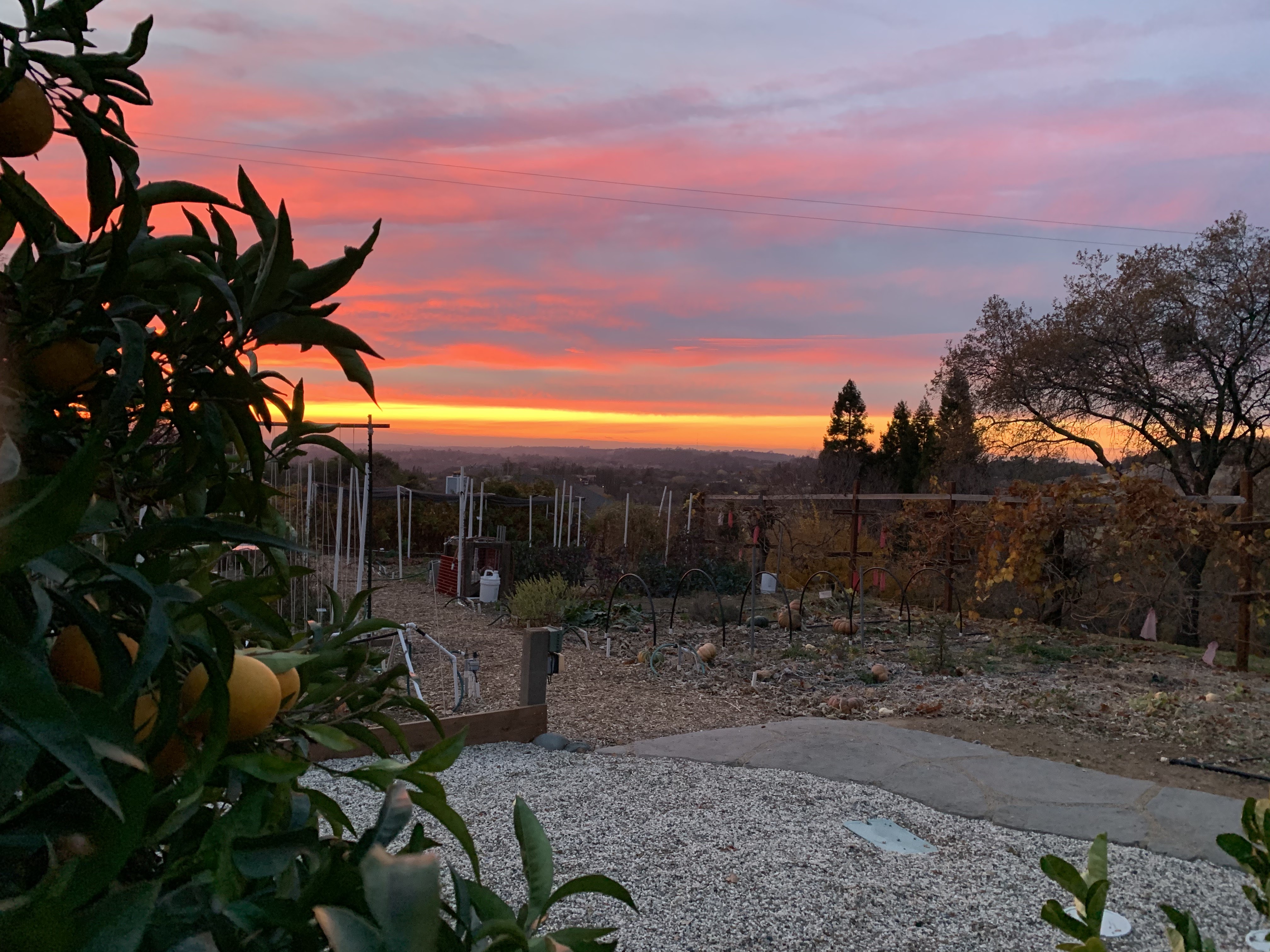
3 decades later it is time for that couple to pursue a new dream, and to pass their heritage on to another lucky family.

We truly are thankful for the opportunity we were given to have spent 34 wonderful years on this very special place on our planet. Turning it into a farm and homestead filled our lives with pleasure and purpose. You will never know how important the support of our customers and friends, our Burgeson Family Farmily, has been through the years in making our dream come true.
We will miss you more than we can ever say.
With love always,
The Burgesons
A Photo Tour of Burgeson Family Farm

On Burgeson Family Farm, our Satsuma mandarins are our primary crop, but we have planted a variety of specialty citrus and other fruit on our two acres in Newcastle, California.
Big changes are coming to our farm over the next few weeks, so stay tuned. In the meantime, I am taking a trip down memory lane by sharing these photos of some of the fun things we have grown on this fertile piece of the planet over the years.
About 10 years ago we started planting avocados. We are growing the Mexicola, Stewart and Pinkerton avocados and are having some great results with these more frost tolerant varieties.
The white powder on the tree is called Kaolin Clay. It is a fine organic clay powder we mix with water and spray on some of our trees such as apples and avocados. It protects the fruit and leaves from sunburn and also discourages insects. It washes off the fruit after we harvest.

Mexicola Avocado.
Mexicola avocados have a very thin skin and buttery flesh. The skin is actually edible!

During harvest season we often will host and open house where we offer citrus tastings.
If you have never tried some of these specialty citrus fruits, seek them out when they are in season and have a taste.
We are famous for our sweet, seedless, easy to peel Satsuma mandarins.
Satsuma Mandarins
Have you ever tasted Algerian clementines? They are incredibly sweet. They do have seeds, unlike our Satsumas.
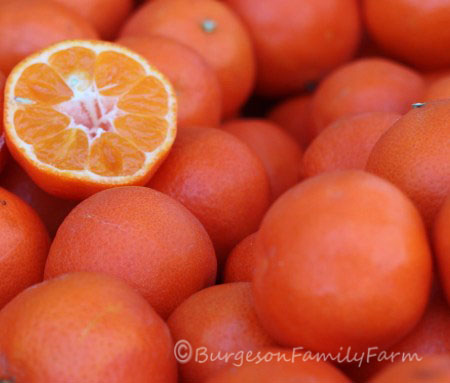
Algerian Clementines
Our first citrus crop in the fall is usually the Persian (Bearss) Limes. They have no seeds and have more juice than most store bought limes. They start out green and eventually turn yellow but can be used when they are yellow or green. The yellow ones are more juicy and sweet, the green ones are more tart and aromatic.

Persian (Bearss) limes
Key limes are small, and have seeds, and are more tart than the Persian limes. Most importantly they are grown right here on our farm, not imported from Mexico. We use no pesticides or herbicides in growing any of our produce. Key limes can be used in any recipe calling for limes. We use them in cocktails.
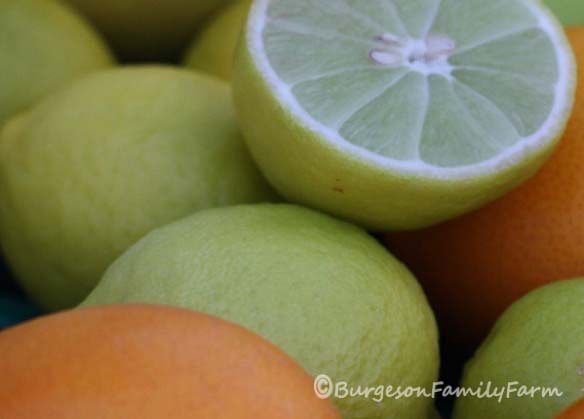
California Key Limes
Oro Blanco grapefruit are like a Pomelo, with very thick skin and sweet, juicy flesh. We peel them and eat them like an orange, and will often remove the membrane from each segment as it is so easy to remove. When you eat a peeled Oro Blanco segment, you will agree it is the sweetest grapefruit you have ever tasted. Because they are so juicy, they are fabulous for fresh squeezed grapefruit juice and have a very high yield. Of course you can also cut them in half and eat them with a grapefruit spoon but expect them to have more juice than a typical grapefruit.
 Oro Blanco Grapefruit
Oro Blanco Grapefruit
Sanguinella blood oranges have a sweet tart flavor, with a hint of raspberry. They are popular for using in savory dishes and salad, they make beautiful juice for cocktails and delicious marmalade. Blood oranges are also fun to eat sliced in wedges. Try tucking some wedges in a child’s lunchbox for fun. Kids love the name and the color!
 Sanguinella Blood Orange
Sanguinella Blood Orange

We also grow Tarocco blood oranges.These are interesting in that they color up and sweeten in storage after harvest so we usually keep them for several weeks after harvest before selling or eating them.
Cara Cara oranges have pink flesh and otherwise are similar to a Navel orange.

Cara Cara Orange
Washington Navel and Valencia oranges are your more common varieties, and they seem to be especially sweet when grown on our Sierra foothills property. Washington Navels are eaten as a fresh orange. The juice will turn bitter soon after pressing. Valencia oranges can be used as fresh fruit or for juice as they are the traditional Florida juice orange.

Valencia orange
Meyer Lemons are the most frost tolerant of all lemons. They are very sweet, aromatic, and juicy, with soft skins, and as the season progresses they get bigger, with thicker skin. Meyer Lemons are actually a cross between a mandarin and a lemon

Meyer Lemon
Our Meyer Lemon tree typically gets between 500 and 1000 pounds of fruit per year!
We have 2 types of apple trees, Granny Smith and Winesap. The Granny Smith apples get very sweet and delicious if you leave them on the tree until late fall. Winesap apples develop more flavor and sweetness when you store them for a week or two after you harvest them.

Winesap apples
Adrian has planted a lot of pomegranate trees over the years.
 We especially like the special Parfianka variety shown below. They have softer seeds than the “Wonderful” pomegranate you typically see in the stores and the seeds are easier to remove from the skins.
We especially like the special Parfianka variety shown below. They have softer seeds than the “Wonderful” pomegranate you typically see in the stores and the seeds are easier to remove from the skins.

Parfianka Pomegranates
We love to make juice from pomegranates by removing the seeds, then pressing them with this little tabletop press.

We grow a large crop of garlic every year, then set some aside to plant for the following year. Some varieties last longer after harvest, giving us home grown garlic year round.

There are several types of garlic shown here. The big red ones are Spanish Roja. They grow very large in our well drained soil.
Winter squash is another crop that can be grown over the summer and stored to be eaten for much of the winter.

Butternut Squash
We have found that Sweetmeat squash, which are larger, last a bit longer in storage than the Butternut.
Quince are an old fashioned winter fruit. We have one dwarf tree and it is prolific.
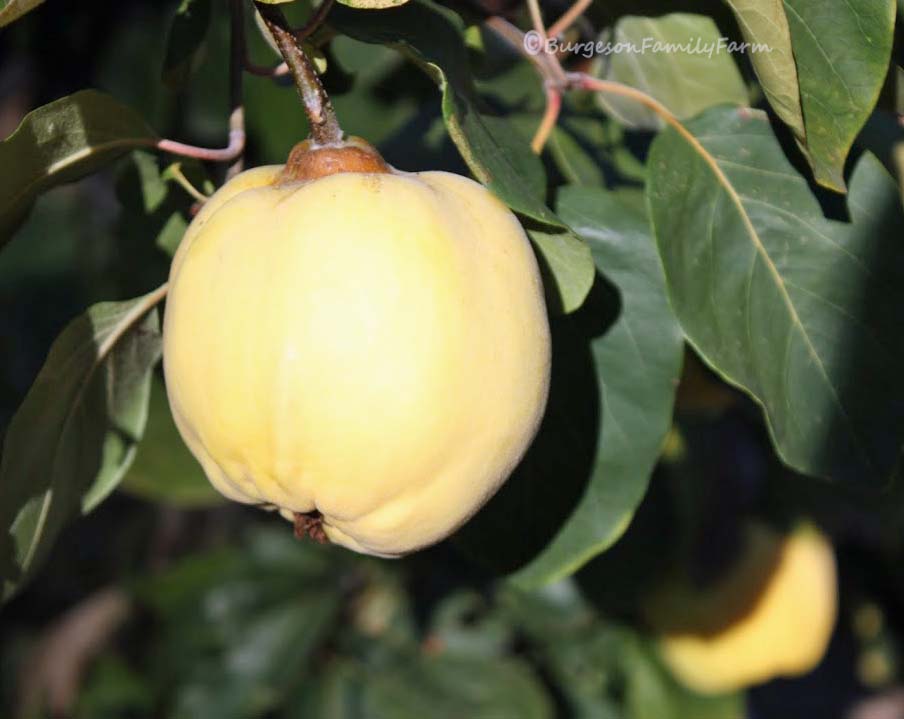
Smyrna Quince
Quince must be cooked to be eaten and will turn a lovely pink color as they cook.
Fall is olive harvest season.
 .
.
We typically use some of the olives for preserving and the majority of them to make oil which we use throughout the year.
Fuyu persimmons are also harvested In the fall.
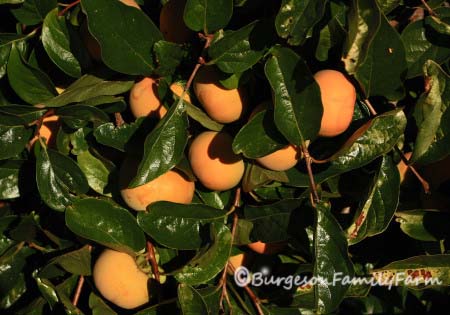
Fuyu Persimmon
Fuyu Persimmons can be eaten when crispy, like an apple, or when soft. Unlike Hachiya persimmons, they are never bitter.
In the summer we usually plant a vegetable garden. We especially have success with tomatoes, peppers, cucumbers and squash.

Tomatoes are great to can, freeze or dry for the winter so a big crop is no problem.
Figs are another great summer crop and some of the heirloom varieties we are growing are giant!


Black Mission Figs
We like to dry the figs to eat for snacks during the winter.
We are not animal farmers, but when our son was young we did have chickens. He loved to play with them

This is the time of year when all of these trees start blooming in preparation for another harvest season on the farm. The farm is abuzz with the humming of thousands of bees at work.


The scent of so many citrus trees in bloom is intoxicating!
Before we know it, we will have made another trip around the sun, and the trees will be loaded and waiting for harvest once again.

Thanks for visiting. We hope you enjoyed this little tour of Burgeson Family Farm
© 2021 Dayna Green-Burgeson RD, CDE. All Rights Reserved.
Reproduction of any content in the article without the written permission of the author is prohibited.
Can you grow avocados in Northern California? Yes!

Mexicola Avocados
About 10 years ago we started investigating what avocados would grow in our Northern California Sierra Foothill location. We are at 1000 feet, and do experience an occasional frost, as well as very hot weather in the summer. Avocados are grown in California, but the varieties you see in the stores, such as Hass and Bacon, are typically grown in mild southern California coastal climates. However, after research we determined that Mexicola hybrids (Mexicola, Mexicola Grande and Mexicola/Stewart) and Pinkerton were some of the best to try in our area so we planted a small orchard of these. The Mexicola types have all gotten mixed up, we are not sure which tree is which now, but they all provide similar fruit.
Our Mexicola hybrid trees have gotten very tall, some of them over 20 feet tall now, and set a crop in the Spring that ripens over the summer and is ready to harvest in the fall. We have found that the trees like a lot of water, and they also are heavy feeders so they receive a lot of compost and organic fertilizer. The fruit does not store well on the trees once the tops start blackening, as the thin skin has a tendency to crack around the neck. We just wash the fruit, peel it and eat it anyway but try to harvest the fruit before it develops these cracks.
This year our crop finally is abundant enough that we are actually able to sell our Mexicola avocados. These avocados have a very thin skin (you can actually eat the skin). They ripen from the neck down, so at first they will be green, then the neck will blacken and soften, and finally they will blacken and soften and the skin will slightly wrinkle. Then they are ready to eat!

The first citrus of the season: Limes
The first citrus of the season to ripen in our Sierra Foothill Location are limes. These will be followed by Satsuma Mandarins, then Meyer lemons, Oro Blanco Pomelos and finally Blood and Navel Oranges as we progress into the winter. We grow both Persian limes, also called Bartender’s Limes, which are the large juicy seedless limes you usually see in the grocery store, and Key limes, which are tart, small, tinged with yellow and have many tiny seeds.
Most supermarket limes are grown in Mexico, harvested when they are barely ripe, shipped to the US, and often stored for weeks before purchase. They tend to be low in juice content due to these harvest conditions.
In contrast, our limes are grown right here in the Sierra Foothills of California, using no pesticides or herbicides, and they ripen to perfection in the autumn sun. As limes ripen they color up from dark green, to a lighter green, and then finally yellow. We pick them at the light green stage, sometimes with a touch of yellow, and they are very juicy and flavorful. Once you have tried these limes, you will never take a lime for granted again.
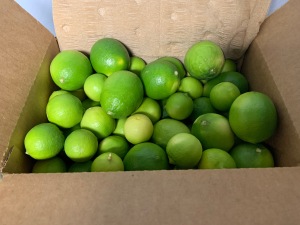
Opening a box filled with our limes is like aromatherapy.
Mojo marinade made with our fresh limes will upgrade your grilled chicken thighs and pork loin. Try this recipe.
Check out these delicious recipes on our website for our juicy limes: creamy citrus pops, key lime pie.
Our absolute favorite cocktail made with fresh lime juice is called the New Spain.
Demand for our limes was great this year and we are now sold out for the year.
.
Creamy citrus pops
Citrus season on Burgeson Family Farm always starts with the lime harvest. Before the very hot summers have faded to the crisp days of autumn we treat ourselves to cool lime-centric drinks on the porch in the evening: gin and tonic, greyhound and margarita cocktails and sparkling water on ice with generous wedges of lime plucked from the tree just minutes before. When I walk by the trees, laden with fruit, it is almost impossible for me to resist grabbing a lime, scratching the aromatic rind and inhaling the intoxicating aroma.

Limes on the trees at Burgeson Family Farm. Note the bees are at work pollinating a new crop which will be ready in the spring. It is uncommon for us to have 2 crops in one year but it looks like it will happen this year.
This is the pop recipe that “started it all”, the pop obsession in our family. Lime pops are so cool, creamy and tart; it takes only 3 ingredients and minutes to make the mix, and to me they are more satisfying and delicious than a key lime pie. This recipe will work with any limes, either the small little Key limes with their intense acidity and aroma and multitude of tiny seeds, or the big juicy seedless Bearss limes, or even store bought supermarket Mexican limes. We have also made this recipe with lemons which make a kind of frozen lemon meringue pie pop.
Key limes on the left and Bearss limes on the right
(Many people think that only key limes are yellow but all limes will turn more yellow when they are very ripe. Note the Bearrs limes are actually more yellow than the Key limes.)
If there is a farmer in your area growing limes, I urge you to buy some at least once to make this, or your cocktails, with them. Most of the limes in the grocery stores are shipped from Mexico, and they are far from freshly picked. The oils in the zest of a freshly picked lime add so much to the flavor of this recipe. You may want to keep one on hand to “scratch and sniff” for a pick me up.
3 Ingredient Creamy Lime Pop Recipe
For this recipe you need only 3 ingredients:
Limes (4-5 large ones or about 10-14 small ones)
1 can of sweetened condensed milk (14 ounces) (I use organic)
1 ½ cups of non-fat Greek yogurt (I use organic, usually either Straus, Clover or Wallaby because I have actually seen their farms and “happy cows” as I travel about Northern California)
(Note, if you want a creamier, more decadent pop, you can replace some, or all of the Greek yogurt with softly whipped cream. Now you really have an ice cream bar!)
Finely zest the rind from the limes. I love this little tool, a microplane grater, for making a very fine zest: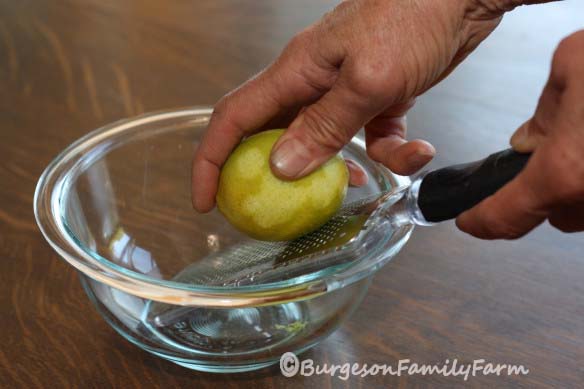
You should have 2 Tablespoons of zest. Note the beautiful fine zest this tool makes.

Squeeze the juice from enough limes to make ½ cup. This handy citrus juicer makes that task a breeze.

Put the juice and zest in a bowl. Stir in the condensed milk. Add the Nonfat Greek yogurt and/or whipped cream and mix well. I use a hand whisk. You can also whip it in a blender which will make the mixture fluffy and the pops will be more light and creamy once frozen.

(I like to mix it in a measuring cup with a pour spout for easy pouring into the molds).
Note: These are high in protein and low in fat (see the analysis below). If you would like the recipe to be even higher in protein and lower in sugar and fat, you can add more of the Greek yogurt. That can be done according to your taste, as it will make them tart. They also will be a bit less creamy.
Pour the mixture into the popsicle molds. This recipe will make 10 popsicles of about 1/2 cup each.

If you don’t have molds you can use small paper cups, but I urge you to consider buying some popsicle molds. They are the most used piece of kitchen equipment we have purchased in a long time.
Put the popsicle sticks in the molds.
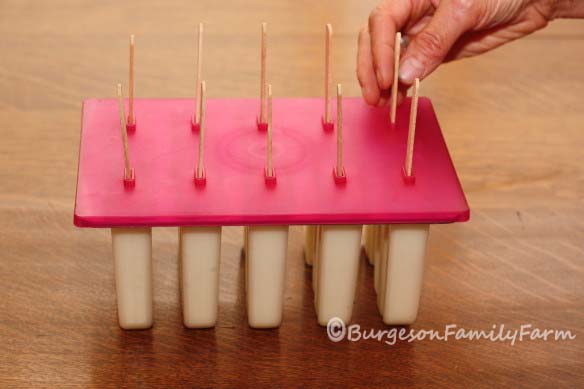
Don’t shove the sticks all the way to the bottom. That will leave a short stick for eating. The mixture should be thick enough to suspend the sticks at the right depth. If not, freeze for awhile and then insert the sticks about halfway into the molds.
Now put the molds in a flat spot in your freezer and patiently wait for at least 4-6 hours for them to freeze completely all the way through. The sticks must be completely frozen in the middle of the pop.
To remove the popsicles from the molds put some very hot water in a glass. (I heat the water in the glass for a minute or two in the microwave). Dip the pop in the hot water for 10-20 seconds or so, until it slightly releases from the sides of the mold. Now squeeze the mold a bit to loosen the pop, hold the pop with the handle facing down and slide it out of the mold. If it does not come out easily, do not pull too hard on the stick or it might come out of the pop. Instead, heat it in the water again until it releases easily.
You can refreeze the pops on a tray until they are very hard, so they don’t stick together, then store them in a container or plastic bag in the freezer. They theoretically will last a long time, but practically speaking, it is doubtful they will be around all that long. They are that good.

Creamy Lime Pops
Nutrition Analysis per Pop (Makes 10):
152 calories, 6 grams protein, 24 grams carbohydrate, 3 grams fat, 2 grams saturated fat,
© 2015. Dayna Green-Burgeson RD, CDE. All Rights Reserved.
Pomegranates: How to get to the seeds; how to make juice
Pomegranates are such a beautiful, nutritious fruit that it is a shame that so few people get the chance to enjoy them. Many are intimidated by the process of removing the seeds, and obtaining juice from the seeds is even more overwhelming. But the delicious reward for your endeavours is unequaled, and it really can be a relatively clean and painless process if done correctly.
Often the pomegranates you buy in the store have been picked before they are fully ripe. The best pomegranates are the ones that are picked when they are so ripe they have started to crack. Obviously at this point they do not store well but this is when the color is the darkest and they are the most sweet. We try to pick our pomegranates right before they crack. Unfortunately when I picked today we had waited so long many of them looked like this.
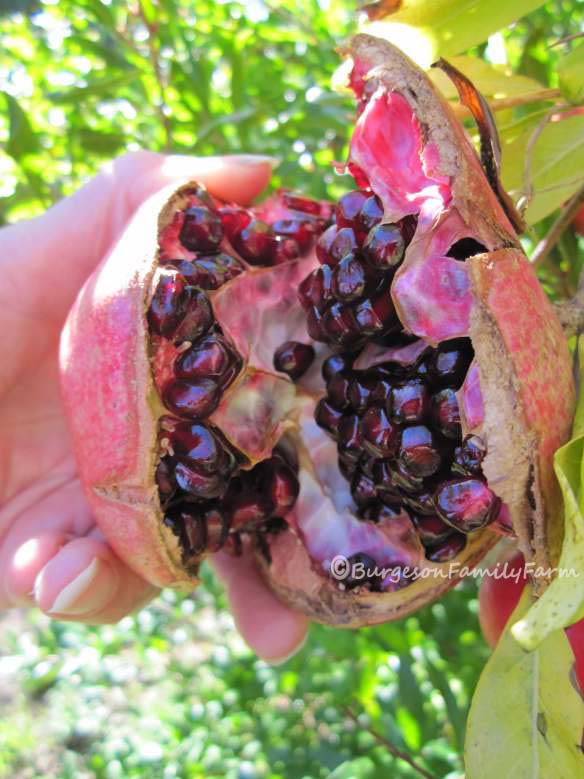
I won’t be able to sell this pomegranate but it will make great juice and it will be easy to open!
We use most of the pomegranates we grow to make juice. We love to
mix the juice with tonic water, or spirits such as vodka or tequila to make
cocktails. It also can be boiled down to make pomegranate syrup to use in
cooking.
We tried using citrus presses and other easy methods to make
the juice, but we have found that the skin and pulp impart bitter flavors to the juice
so we have gone back to using a somewhat laborious method which involves
first removing the seeds from the pomegranate, then getting juice from the
seeds.
Here is how to get the seeds from the pomegranate:
First remove the skin from the top and bottom of the
pomegranate. Cut around the circumference but only through the skin, not
deep enough to cut the seeds. This will prevent the task from becoming a big juicy mess!

Cut around the circumference of the pomegranate both top and bottom but do not cut through the seeds, only through the skin.
Now peel off the skin. Notice the seeds are whole.This is because they were not cut with the knife.

Peeling off the top and bottom to reveal the lovely seeds inside.
There can be some pomegranate spray, so I usually do this step and the steps afterwards holding the pomegranate under a bowl full of water. The water contains almost every bit of spray. If I do this while watching TV rather than outside or in the kitchen, I cover the sofa with an old sheet as an extra precaution.
Now cut from top to bottom in about 5 or 6 locations around the perimeter of the pomegranate. Again, these are shallow cuts that only cut the skin, not the seeds.

Now break the pomegranate apart along the natural segments, and remove the seeds from each segment. This is less messy if it is done under water.

Note the natural segments of seeds that have separated from the skin and membrane. Gently scrap away those seeds from the membrane and let them drop into the water.
The white pulp will float to the top and the seeds will sink to
the bottom of the water. Now skim the pulp off the top of the water,
and strain the seeds, and they are ready to go.

If you dry the seeds on a cloth and then store them in a sealed container in the refrigerator, with folded paper towels on the top of the seeds, they can last for weeks. You can sprinkle them on salad, on your yogurt and oatmeal or just grab handfuls for snacks.
If you want to take it to the next level, you can make juice.
Here is a huge soup pot filled with pomegranate seeds ready for making juice.
Adrian often does this job while he is watching TV. He covers the sofa with a sheet because he prefers to not use the water, so it can become a somewhat messy job. Check out that sheet. Sometimes it looks like a massacre has occurred in our living room!
The juice can be made with either raw or cooked pomegranates. We have found it is somewhat sweeter if we cook them. If you are planning to make juice and do not have a juice press, you should heat them to get the maximum yield. Put a small amount of water in the bottom of the pot, smash them down slightly with a potato masher to release more liquid, put on the cover, and slowly heat the pomegranates, stirring occasionally, until they have come to a simmer and have broken down but have not boiled, and the juice has been released. Then let them cool.
These are the pomegranates after heating and cooling. They are now ready to be pressed.

Cooked pomegranate seeds ready to be made into juice.
The seeds are then placed into a juice bag which we purchased, along with our little tabletop press, at The Beverage People, which is in Santa Rosa. We have also seen small tabletop presses for sale at O’hara Brew House Supply in Auburn. Ours is an Italian Fruit Press and is made by Ferrari. You can also use a large piece of muslin if you are planning to squeeze the juice by hand.

Pouring seeds and juice into tabletop press
Before we had this tabletop press, we used a large old wine press we had, and before that we just used muslin or a cloth bag and squeezed by hand. The little tabletop press is by far the best way to go when you have a lot of pomegranates and are planning to make juice every year.
If you are doing this by hand, just place the pomegranate seeds in a fine mesh strainer and let the juice run out freely. Then put the seeds in a muslin bag or in the middle of a large muslin piece and twist the top until the juice is squeezed out of the bag. Continue to twist and squeeze the bag or fabric until you can get as much juice out as possible. You can get about 3/4 of the juice out without using a press. We got about 1 cup of juice per pound of seeds squeezing by hand. This is the seeds from 2 large pomegranates.
We put the bag of pomegranate seeds in the press, gradually
screw it down to create pressure on the seeds and the juice runs out of the
spout into our collection device.
This may be the best pomegranate juice you have ever tasted!
From there we pour it into bottles and freeze or can it to use year round.
Nutrition Note: pomegranates are high in phyto-nutrients
associated with a reduction in disease. Much of the strongest research has suggested that eating pomegranates or drinking the juice can reduce the risk of cancer and heart disease. The research on reducing the risk of prostate cancer has been especially promising.
We have pomegranates for sale on the farm now. Please contact us using this link to place an order.
© 2015. Dayna Green-Burgeson RD, CDE. All Rights Reserved.
Key Lime Pie
The first citrus crop to ripen on our farm are limes. The harvest starts in early Fall.
We grow both key limes and Bearss limes on our farm here in Newcastle, California. Both are tart, juicy and delicious and can be used in this recipe. The Key limes are small, with many seeds, and are a bit more tart than the Bearss limes, which are seedless, large and juicy. Both limes will turn more yellow as the season progresses.

This recipe is for a delicious, easy frozen key lime pie. It is so refreshing after a rich meal and it is so simple to prepare.
Easy Frozen Key Lime Pie
Use any recipe you like, or purchase a premade graham cracker crust:
Mix until blended:
1 Tablespoon grated lime rind
1/2 cup of lime juice
1 can of sweetened condensed milk.
Fold in:
1 cup of whipped cream (or for a lower fat version you can use Greek yogurt to replace some, or all of the cream)
Pour this into the pie shell and freeze until solid (at least 3 hours).
You can also top with more whipped cream and shredded lime rind to pretty this sweet treat up.
Do you wonder how you can purchase our Key Limes? Contact our farm to arrange to pick them up.
Satsuma salad with bacon
 My son sent me a text message the other day that said “bacon and Satsumas make a delicious breakfast”. That got me thinking that the combo of Satsumas and bacon, that sweet and salty duo of favorite flavors, could be a good start for a few tasty recipes. This is my first rift on that theme and tasty it is indeed.
My son sent me a text message the other day that said “bacon and Satsumas make a delicious breakfast”. That got me thinking that the combo of Satsumas and bacon, that sweet and salty duo of favorite flavors, could be a good start for a few tasty recipes. This is my first rift on that theme and tasty it is indeed.
Satsuma salad with bacon.
This recipe serves 4 as a side salad. As a main dish, it could serve 2 and would be yummy with added smoked turkey or smoked chicken for some extra protein.
Ingredients:
1 cup fresh squeezed satsuma mandarin juice (our Satsuma are so juicy you can even do this by just squeezing them in your hand, or use a citrus reamer or other juicing device).
¼ cups thinly sliced peeled shallot
2 Tablespoons olive oil
2 teaspoons Dijon mustard
2 tsp. white wine vinegar.
¼ tsp. or less salt
6 slices bacon, chopped in large pieces, cooked until crispy and drained (save the bacon grease).
8 cups greens (I used escarole) torn into pieces. Spinach, sturdy lettuce or thinly sliced kale are other options for this salad. Arugula might also be a nice addition.
2 cups mandarins (peeled, cut in half and then segmented so they are individual segments cut in half)
2 ounces Feta cheese (I like to use the Danish Piknik sheep’s milk cheese which comes in a can with brine. It will store for a long time in the refrigerator in the brine. I find mine at middle eastern or European grocery stores).
To make the dressing, boil the Satsuma juice on the stove until it is reduced to a thick syrup (down to about 1/3 cup total volume). Add the sliced shallot the last minute or two of boiling, then let it cool down. Now add the olive oil, Dijon mustard, white wine vinegar, 1 Tablespoon of the reserved bacon grease and ¼ teaspoon or less salt (to taste) and mix well.
Put the greens in a bowl and add the mandarin pieces. Mix with the dressing. Serve into 4 bowls then top with the bacon pieces and crumbled white cheese.
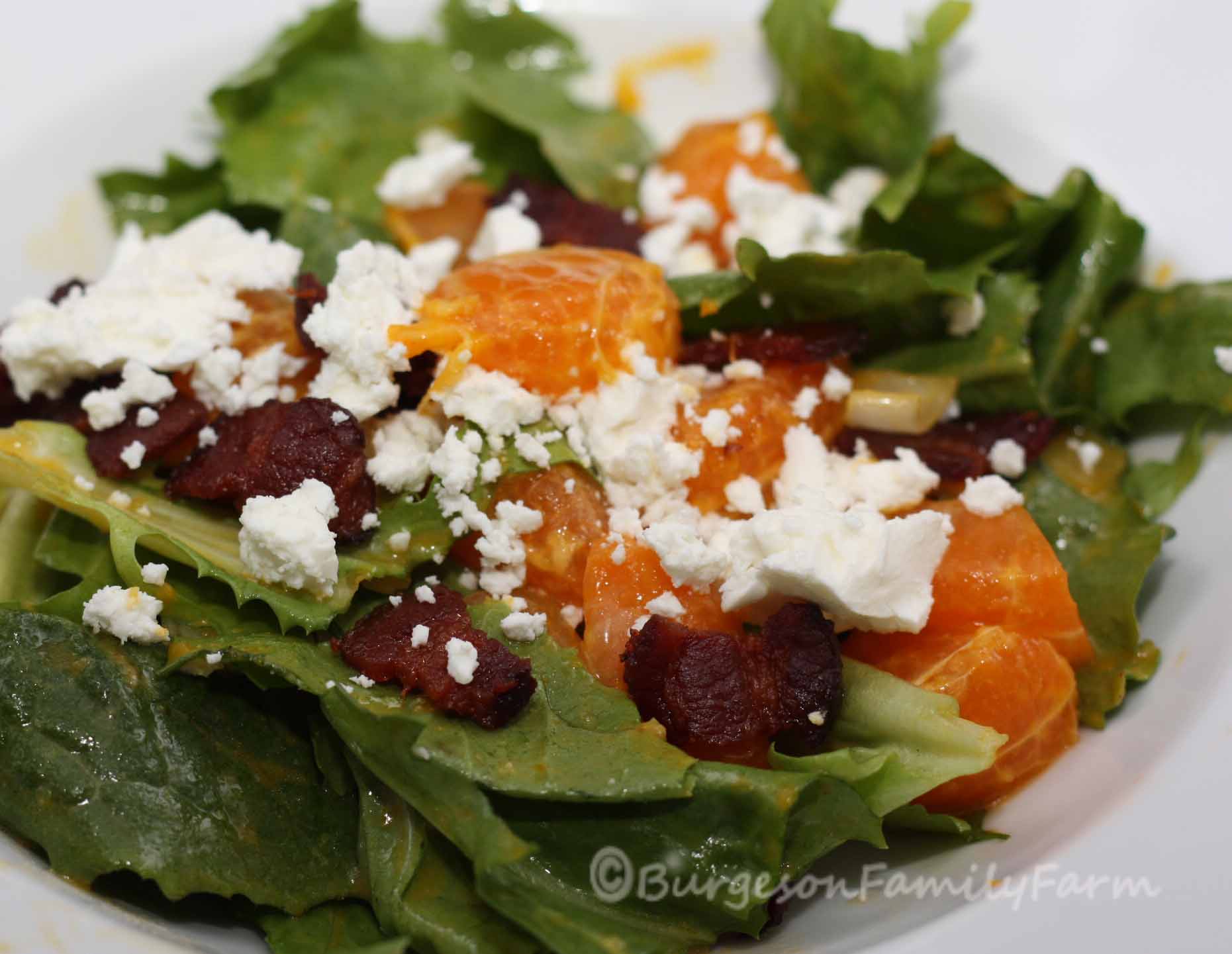
Satsuma salad with bacon
To read more about our Satsuma mandarin farm, or to order our Satsuma mandarins to use in this recipe, please visit www.burgesonfamilyfarm.com.
Frozen Satsuma Smoothie
Satsuma Mandarin season is short and sweet. The fruit does not last very long on the trees after it is ripe, so we pick it as soon as possible. Usually Satsuma season only lasts for a month or two, but there are ways to preserve them to enjoy that goodness year round.
We like to peel the Satsumas, section them and freeze them on cookie sheets. Once they are frozen we seal them up in plastic baggies which we tuck away in the freezer to use later in the year. We also squeeze the juice and freeze it in ice cube trays or milk cartons to use later in cocktails or as juice for breakfast.

Gold from the freezer. This is the way to carry mandarin season into the summer!
Our favorite use for the chunks of frozen mandarin juice, or the mandarin sections we have frozen, is to make smoothies. We start with a simple formula, equal parts frozen mandarin juice or frozen mandarin sections and milk. For example use 1 cup milk, 1 cup mandarin sections for 2 servings of about 1 cup each. We like to add a scoop of NorCal Organic (local) whey protein powder before blending it in our blender. This makes it extra fluffy and adds a protein boost for an easy breakfast.
Satsuma Mandarin Whey Protein smoothie. A delicious nutritious way to start the day.
You can use this basic recipe as a base for adding other ingredients. The mandarins are very sweet so no sweetener is needed, although you can add honey if you like. Frozen fruit such as blueberries, raspberries or banana are one way to mix it up. Sometimes we add vanilla or almond extract. Greek yogurt, vanilla flavored or plain, or adds another protein boost. Flax seed, wheat germ or hemp seed also add protein, B vitamins and essential fatty acids. A handful of spinach or kale can give you a full meal in a glass.
During Satsuma season we sometimes sell “seconds” with skin damage, for half price, 80 cents per pound, at our farm. These seconds are perfect for juicing or for peeling and freezing right away to use throughout the year. Contact us to arrange to pick your Satsumas during December and January.
New Years Cheer: Satsuma Mimosas and Cocktails
When we sort through our Satsumas before boxing and bagging them we pull out all of the seconds that are not of sufficient quality to sell. Some of them have damaged skin, or skin that is very soft, and some have hard green spots on the skin. We sell these
seconds for half price at the farm, 80 cents per pound. They are very perishable due to the skin damage so they should be cut and juiced, or peeled and sectioned soon after purchase.
We often peel and freeze the mandarin sections and used them throughout the year for smoothies. These mandarins are still very sweet and juicy however, so they also make great mandarin juice. We just cut them in half and juice them using a citrus juicer. You can even squeeze them by hand, they are so soft and juicy.

Delicious fresh Satsuma Mandarin juice
This juice can be mixed with sparkling wine for a delicious Mimosa, or can be mixed with sparkling water for a non-alcoholic holiday toast.
We have also come up with some delicious cocktail recipes using the mandarin juice.
Sierra Sunset Cocktail
In addition to using the fresh squeezed mandarin juice, this recipe uses pomegranate juice, sweet sparkling wine such as Proseco, and Grand Marnier. The recipe for our home-made pomegranate juice is here:
https://burgesonfamilyfarm.com/2018/10/05/pomegranates-how-to-get-to-the-seeds-how-to-make-juice-2/
Fill a glass with crushed ice. Fill the glass with slightly less than 1/3 pomegranate juice, then add 1/3 sweet sparkling wine and 1/3 mandarin juice. Finally pour 1 Tablespoon of Grand Marnier over the top.
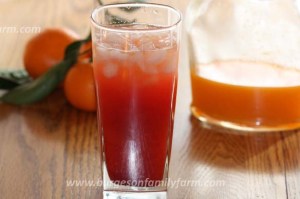
“Sierra Sunset Cocktail”
For a non alcoholic version, fill the glass with 1/3 pomegranate juice, 1/3 tonic water, and 1/3 mandarin juice.
Mandarin Vodka Tonic
Fill a glass with crushed ice. Mix 1/2 cup mandarin juice, 1/2 cup tonic water and 1 shot of vodka and pour over the ice.

“Mandarin Vodka Tonic”
You can also make a delicious Satsuma Mandarin Margarita.
Satsuma Mandarin Margarita
Mix together :
3 shots fresh squeezed Satsuma mandarin juice
1 shot white 100% agave tequila (such as Patron silver)
½ shot Cointreau
½ shot fresh squeezed lime juice
Pour this over ice in a glass and serve immediately.

If you would like to purchase our mandarins during the winter months please contact us using this link.
© 2013. Dayna Green-Burgeson RD, CDE. All Rights Reserved.
Reproduction of any content in the article without the written permission of the author is prohibited.
Candied Mandarin Rind
 Don’t toss out the rinds of our Satsuma Mandarins. They make delicious candied rinds to eat as a treat or to use in baked goods or candy. We love to make panforte out of our candied mandarin rinds.
Don’t toss out the rinds of our Satsuma Mandarins. They make delicious candied rinds to eat as a treat or to use in baked goods or candy. We love to make panforte out of our candied mandarin rinds.
For success with this recipe I recommend you have a candy thermometer or an instant read thermometer to check the temperature of the syrup throughout the process. You also should have some parchment paper, non-stick spray or vegetable oil or shortening, a good sized saucepan with a lid, and some type of heatproof strainer. Optional items are a cooling rack, and a dehydrator.
Ingredients are only the rinds, lots of sugar, and water.
When you are peeling the Satsumas, it is easy to keep the rinds in large pieces since the rinds usually separate so easily from the fruit. Larger rinds will be easier to candy although if you plan to use chopped rind in panforte or another recipe you can also chop the rind before candying it. In this case you may not cook it to quite as high of a temperature in the final step (try 225-230 instead of 240), as it may fall apart. When I do that, I use it right away in recipes after draining it as chopped rind is harder to dry and store.
As you are eating the Satsumas, save your large nice looking rinds in a plastic bag in the refrigerator until you have enough to make a batch. For many of our customers this does not take very long! Remove any stem ends and slice or chop if desired, or leave in good sized pieces (¼ to 1/3 of a total mandarin rind is a good size)

Once you have about 6-7 cups of rinds, you are ready to candy them.
Cover the rinds with a lot of water; you cannot really use too much so a large stockpot is useful here. Bring the water to a boil, boil for 10 minutes, then drain the rinds. Do this one more time. This softens the rinds and removes some of the bitterness. Note, mandarins can have much softer rinds than other citrus so use your judgement here. If the rinds are very soft and thin you may need to shorten the boiling time or only use one boil. Make sure they do not get so soft that they will fall apart in the next step.

Once the rind has been softened by boiling, drain it and set aside.

Now, in a medium to large sized saucepan, make a syrup using 3 cups water to 6 cups sugar. The height of the syrup should not be more than about ¼ up the sides of the pan. This allows room for boiling and for adding the rinds. Stir the sugar into the water, and gradually heat it making sure it dissolves. There should be no sugar crystals on the side of the pan so wash it down with a pastry brush with water or put a lid on the pan for a few minutes to let the steam build up to wash down the sides. Be careful not to let the pan boil over.
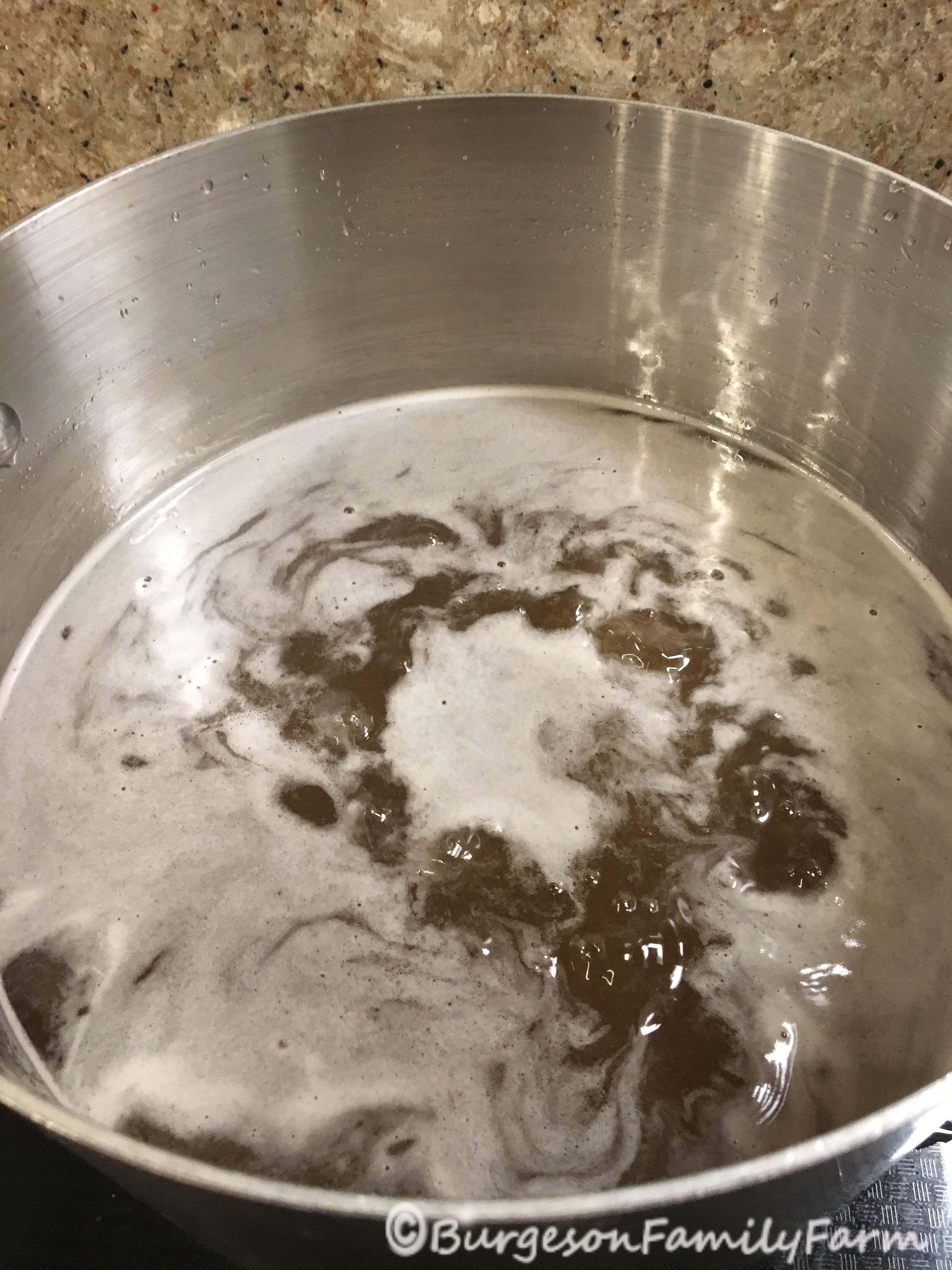
Once the sugar is well dissolved, raise the temperature of the syrup to a rolling boil and continue to boil until it has reached the “thread stage” which is 230 F on a candy thermometer.
Now add the rind to the pan and stir it in. Tuck the rind under the syrup as best you can so it is all being infused in the syrup.

Put a piece of parchment paper over the rind to help hold it under the syrup.

Now let the rind slowly simmer in the syrup for about 1 hour. Once in a while you may want to remove the paper and gently stir the rind a bit and tuck it under the syrup again to make sure all of it gets infused with the syrup.
NOTE: Excessive stirring can break up the rind, and also cause sugar crystallization so a gentle touch with minimal stirring is important in this recipe.
After one hour, remove the parchment and raise the heat to a good rolling boil. Cook the rind in the syrup, giving it a gentle stir on occasion, especially making sure it does not burn at the bottom, until the syrup thickens and reaches the firm soft ball stage which is 230-235 range on the candy thermometer. Note: If the syrup gets very thick and stirring any more is breaking up the rind, causing it to turn to mush, or if the rind has absorbed most of the syrup, stop cooking and proceed to the next step.

Now remove the rind from the syrup. The easiest way to do this is to strain it in a strainer that has relatively large openings for the syrup to go through, or to remove it from the syrup with a slotted spoon. Be careful, the syrup is very hot and can burn you.
Separate the rinds out on parchment that has been sprayed with non-stick spray or oil, and let them cool. You may want to spoon them onto the paper when they are still hot, then let them sit until they can be touched at which time you can separate them from each other. If they cool all the way while stuck together you will have a hard time separating them.
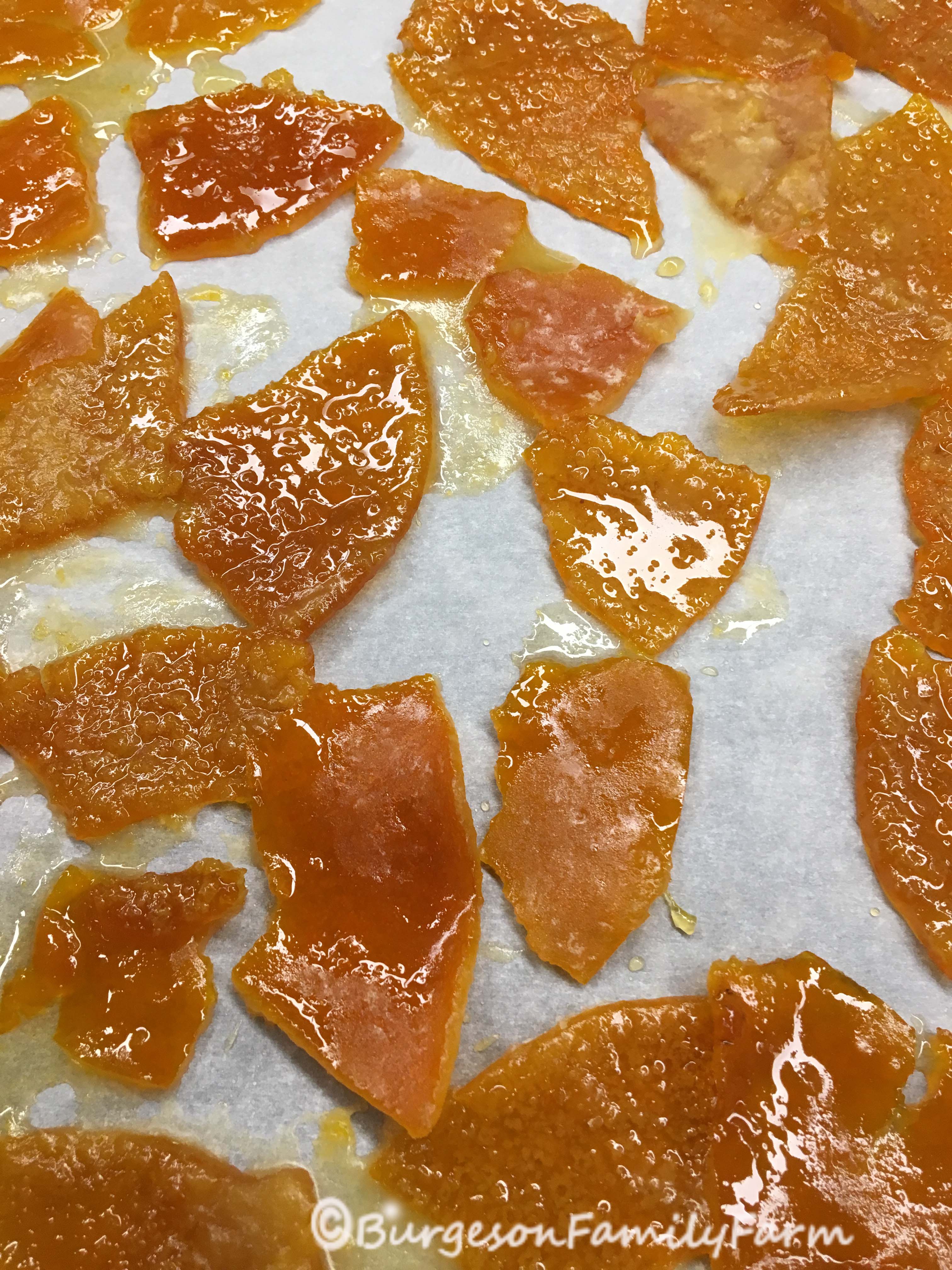
To dry further you can put them on a drying rack that has been sprayed with non-stick spray or oil, and put them in a warm dry place. You can also dry them at 100-110 in a dehydrator or in an oven set on the dehydrator setting or with the oven light on. Once they are no longer sticky they are ready.

To store the rind, refrigerate it or put it in an airtight container and store at room temperature. Make sure it is kept very dry. You can layer it with sugar to help keep it dry. Keep an eye on it and do not store it too long though because if moisture builds up it can occasionally grow mold and spoil.
Use in recipes or serve as is.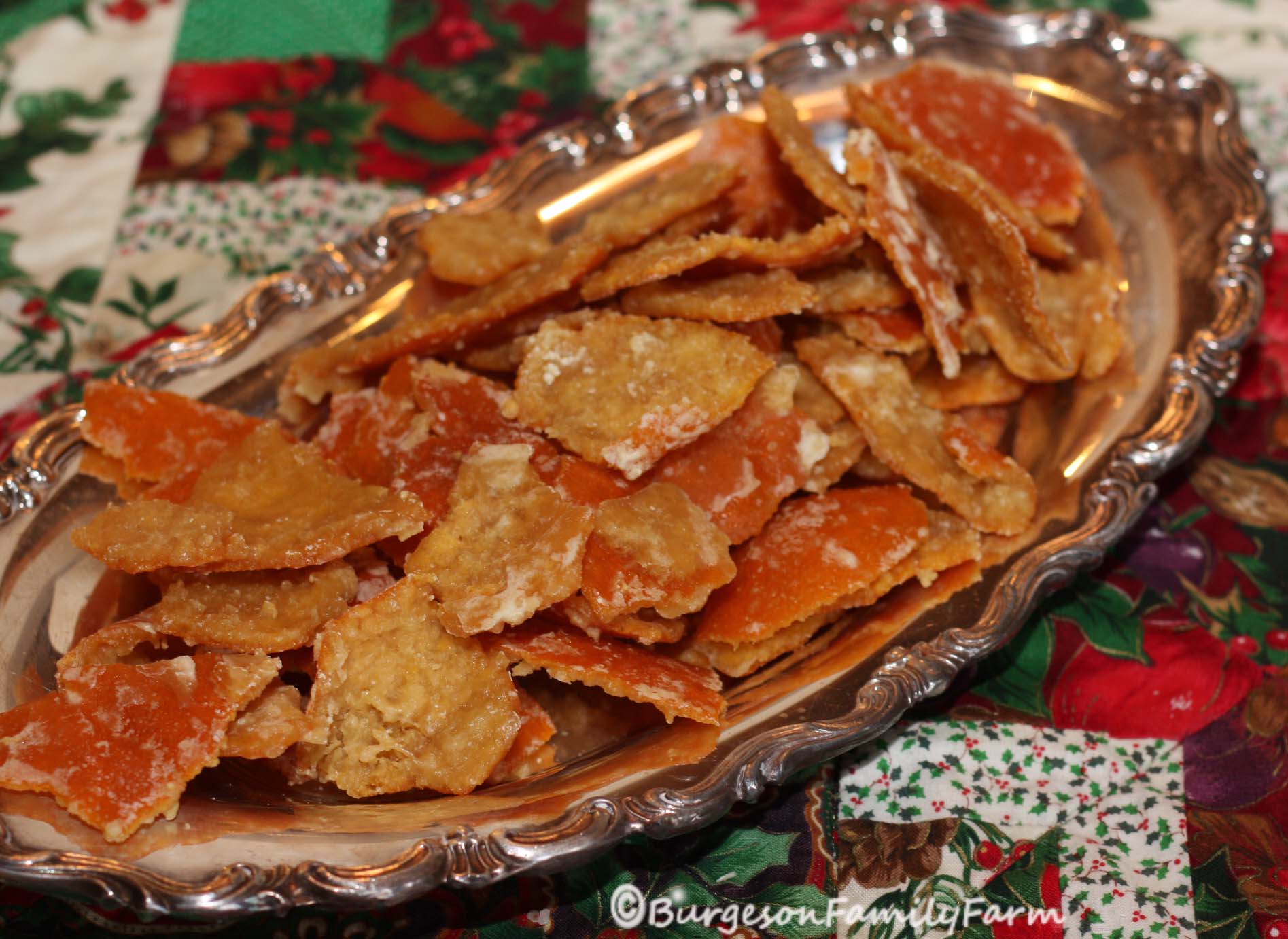
Satsumas and beer
Yesterday after a hard days work picking and packing mandarins we made a delivery to a local brewery, Out of Bounds Brewery in Rocklin. The head brewer ordered some of our Satsuma mandarins to add to a special batch of beer he will be brewing. We sat down for a tasting of the 12 beers available. We are homebrewers and pretty critical of beer so it is rare that we like all of the beers made by a brewery, but this was an exception. The beers were fantastic! We are excitedly awaiting the first beer made from our Satsuma Mandarins which will be available sometime in January. We will post the minute it is available!
Persimmon salsa
 There are 2 types of persimmons commonly available in our area of California. Both ripen in the fall. The Hachiya persimmon are extremely astringent unless ripened until they are jelly like inside. Typically these persimmons are either used in baking or to make the traditional dried persimmon called Hoshigaki. The Fuyu persimmons, which we grow on our farm, are not astringent so they can be eaten when still crispy, like an apple. They also can be eaten when quite a bit softer, and can even be used in recipes to replace the Hachiya if they are ripened to a jelly like state.
There are 2 types of persimmons commonly available in our area of California. Both ripen in the fall. The Hachiya persimmon are extremely astringent unless ripened until they are jelly like inside. Typically these persimmons are either used in baking or to make the traditional dried persimmon called Hoshigaki. The Fuyu persimmons, which we grow on our farm, are not astringent so they can be eaten when still crispy, like an apple. They also can be eaten when quite a bit softer, and can even be used in recipes to replace the Hachiya if they are ripened to a jelly like state.
There is an easy way to distinguish the sweet Fuyu persimmon from the astringent Hachiya. The Fuyu has a rounded bottom, the Hachiya has a pointed bottom.

Hachiya Persimmon on the left, Fuyu Persimmon on the right
I love fruit salsa, and mango salsa is delicious, but unlike persimmons, mangoes are not commonly grown in Northern California. I find the texture, color and flavor of a slightly soft-ripe Fuyu persimmon to be similar to mango and have been using it as a California alternative to mango in recipes. I started making this persimmon salsa several years ago, and I love it on grilled chicken or fish, or it can be eaten with chips like any other salsa.
Use slightly soft Fuyu persimmons if you can. However any Fuyu will work, whether it is still crisp or it is dead ripe soft.

Beautiful Fall Fuyu persimmons
I like the persimmon peeled, so I peel it, remove the seeds and chop it coarsely. For this recipe, use about 4 persimmons or enough to make 2 cups of chopped persimmon. The spiciness of this recipe can be individualized. I use about 1/3 of a very hot Poblano chili that has turned red. I chop the chili very finely. This is about 1/4 cup of chopped Poblano chili.

Mix the persimmon and chili in a bowl with the following ingredients:
½ cup chopped fresh cilantro
½ cup finely diced avocado (1/2 large or 1 small – about 4 ounces by weight)
½ cup chopped scallion or ¼ cup very finely chopped red onion soaked in water for 10 minutes
¼ cup fresh lime juice
1 Tablespoon finely minced fresh ginger
If you do not have fresh chili, (for example jalapeno) you can use Tabasco or Sriracha or other hot sauce to taste. The amount of spice is up to your discretion. I usually just taste it until it is as hot as I would like.

Fuyu Persimmon Salsa
Nutrition Notes: persimmons are a good source of carotenoid compounds (vitamin A like compounds) and lutein and zeaxanthin. This compounds can promote eye health.
By the way, if you are interested in purchasing Fuyu persimmons, or the limes for this recipe, we do sell them at our farm when in season. Read more here.
Here is a link with more information about our farm Burgeson Family Farm
© 2013. Dayna Green-Burgeson RD, CDE. All Rights Reserved.
Reproduction of any content in the article without the written permission of the author is prohibited.
Tough year on the farm.
It is November 13, 2017, and usually by now I have sent emails out to our usual customers with instructions for pre-ordering shipped Satsuma mandarin boxes or bags of mandarins from our farm. This year, no one has received that email, and the phone calls are coming in. What is up with us here on the farm?
In October, our sister farm, Leisen’s Bridgeway Farms, was consumed by the fires in Santa Rosa. My sister Janet Leisen and her husband Corrie lost everything in the fires. The barn, the rental house, the home, most of the trees, the tractor, the walk in for storing produce, the vintage car, the irrigation equipment…everything. My niece, her husband and their two young children who lived nearby also lost their home and everything on their property. We have been preoccupied with helping them and other residents of Santa Rosa however we can. The time has flown by and our normal fall routine was interrupted.
The community in my home town of Santa Rosa, and my family, are in for a long process of rebuilding from the ashes. After the media has moved on to the next news cycle, they will still be struggling and will need all the help that they can get. If you feel concern and would like to help, cash donations are the most useful at this time. The infrastructure for donated item distribution has been overwhelmed so I have noticed first hand the inability of fire victims to be able to obtain, store and utilize donated items.
There is a go fund me account to support Leisen’s Bridgeway farms.
https://www.gofundme.com/leisenfamilyfirefund
There is also a general fund providing support to all the fire victims in the Northern California Fires.
https://www.redwoodcu.org/northbayfirerelief
The other bad news is that with recent changes in weather last year and this year again, we have had extreme heat in the early spring. As farmers we believe in man made climate change as we are personally seeing the effects. This heat has led to extensive “fruit drop” where our mandarins drop most of the baby fruit on the ground early in the season.

Early season heat spells caused the small mandarin fruit to shrivel on the tree.
 That fruit then dropped to the ground, causing significant loss of our crop for the year.
That fruit then dropped to the ground, causing significant loss of our crop for the year.
As a result, we have the smallest mandarin crop in years. We will not be taking orders online for shipped gift boxes at all this year.
We plan to sell mandarins in bags from our farm once we start harvest in a few weeks. We may have a few boxes available at that time to ship to our established customers depending upon harvest conditions.
If you would like to be updated on the progression of the harvest, and supply, and to be notified when harvest begins, please send an email to us and we will put you on the email notification list.
Thank you for your support of our small farm.
Dayna Burgeson
Farmers/Environmentalists/Land Stewards
As farmers we are reminded daily that we are dependent upon the health of our planet for everything. The environmental agenda has taken a backseat in politics recently and as a result we are very concerned about the long term prognosis of the human species on this very small planet. We all must take individual and collective action to help protect the only earth we have in any way we can. As a family we are trying to do our part. When one does not like the way things are, volunteer in whatever way you can to make a difference. It is empowering and you will receive more than you give. We are so proud as a family to have received the Placer Land Trust’s Land Steward award this year. And we love this little youtube video they made.
Thanks to our customers
We are so lucky to have a great family of customers who come back to our farm year after year for their freshly picked Satsuma Mandarins. Every year we get special new customers to add to this growing family.
We have received so many kind emails and comments about our Satsumas, and compiled them here to remind us why we do what we do.
Your oranges are amazing!…JG
Our friend shared some of her shipment of Mandarins with us..they are the most incredible I have ever tasted!…TC
They are beyond yummy, as usual…GM
We just love your lovely mandarins….AE
I have bought Satsuma from 2 other farms but yours are simply the best!!!…KM
Got them, opened them, love them …PD
Oh my goodness! These are by far the best Mandarins we’ve ever eaten! Glenn picked them up last night at the bee meeting and we’ve been consuming them ever since. Thanks again for producing such a wonderful and pesticide free product. YUMMMMMMYYYYY!!!!!!!…GM
I received them on Thursday and they are gone today. My little girls absolutely loved
them, as well as a few guests we had over this weekend for a tamale
dinner. …VM
We are enjoying them very much…RF
I can hardly wait for your mandarins…SM
I received a box of Satsuma mandarins as a gift this week and they
are wonderful…KW
We received a box of your mandarins last year as a gift from a family member (and we’re about to receive one again this year!). They were so delicious that we are interested in sending some as a gift as well…TG
The oranges have arrived safely and all have responded with very positive
comments. Thanks for completing these orders for me…MR
my Dad LOVES them!!…LR
Hi Dayna, I am thrilled to get your mandarins this year. I still wish you
are just down the street…JG
I am looking forward to those great
mandarins from your farm… J.P
You guys really have the best mandarins in the area…JG
Last year my mom sent me satsumas and a few lemons from your orchard, they were fantastic!…YA
Thank you very much for the update. My little girls are already asking when we get that bag of those delicious little oranges. :0) ..VM
Can’t wait to get my share of these Satsuma’s: we had them when we were visiting our friends and grandchildren in California over the holidays and we were hooked. My husband who generally does not like citrus foods that much, kept eating them too…EV
The ones I tasted were sweet as could be and far superior to the ones in the grocery stores!…SO
The box with the mandarins and lemons arrived with todays parcel mail. The fruit is in perfect condition and is as flavorful as only your mandarins are. The best I ever had Thank you…AMW
The Mandarins arrived and they are delicious…JF
Our good friends gave us a box of your indescribably yummy mandarins. She was a little vague about how we could order some for ourselves. I think she wants them all for herself. I’m writing to ask that if possible you please include us as likely customers for you future harvests. Then we could astound and frustrate our friends with mysteriously fabulous fruit just like they do…KM
Got ’em today, as did at least one of my siblings. They’re REALLY good. I’m sure you’re working hard down there, but it’s worth it! …PN
Thank you, received in great shape. They are most delicious and lovely…..DW
I hope you don’t mind me saying this but yours are the crack of mandarins…NK
Your mandarins are so wonderful it’s totally worth waiting until they’re ready….AE
Winter Citrus Tour at Burgeson Family Farm

On Burgeson Family Farm, our hundred plus Satsuma mandarin trees are our primary crop, but over the years we have planted a variety of specialty citrus and other fruit on our two acres in Newcastle, California.
Below is a tour of some of the citrus fruit that we have for sale when it is in season. Customers contact us to order fruit picked to order to pick up at our farm, or at times have our fruit shipped to them through the US Postal Service. Our season starts in the fall, with the limes being the first to ripen. Our Satsuma mandarin harvest starts around Thanksgiving.

If you have never tried some of these specialty citrus fruits, seek them out when they are in season and have a taste.
We are famous for our sweet, seedless, easy to peel Satsuma mandarins.
Satsuma Mandarins
When they are available, we sell Satsumas in 10 pound bags, 5 pound bags and we also ship boxes.

Have you ever tasted Algerian clementines? They are incredibly sweet. They do have seeds, unlike our Satsumas.

Algerian Clementines
Our first citrus crop in the fall is usually the Persian (Bearss) Limes. They have no seeds and are incredibly juicy. They start out green and eventually turn yellow but can be used when they are yellow or green. The yellow ones are more juicy and sweet, the green ones are more tart and aromatic.

Persian (Bearss) limes
We also have Key Limes. They are small, and have seeds, but they are very juicy and most importantly they are grown right here on our farm, not imported from Mexico. We use no pesticides or herbicides in growing any of our produce. Key limes can be used in any recipe calling for limes. We use them in cocktails.

California Key Limes
We also have Oro Blanco Grapefruit. These are like a Pomelo, with very thick skin and sweet, juicy flesh. We peel them and eat them like an orange, and will often remove the membrane from each segment as it is so easy to remove. When you eat a peeled Oro Blanco segment, you will agree it is the sweetest grapefruit you have ever tasted. Because they are so juicy, they are fabulous for fresh squeezed grapefruit juice and have a very high yield. Of course you can also cut them in half and eat them with a grapefruit spoon but expect them to have more juice than a typical grapefruit.
 Oro Blanco Grapefruit
Oro Blanco Grapefruit
Sanguinella blood oranges have a sweet tart flavor, with a hint of raspberry. They are popular for using in savory dishes and salad, they make beautiful juice for cocktails and delicious marmalade. Blood oranges are also fun to eat sliced in wedges. Try tucking some wedges in a child’s lunchbox for fun. Kids love the name and the color!
 Sanguinella Blood Orange
Sanguinella Blood Orange
We also grow Meyer Lemons. They are the most frost tolerant of all lemons. They are very sweet, aromatic, and juicy, with soft skins, and as the season progresses they get bigger, with thicker skin. Meyer Lemons are actually a cross between a mandarin and a lemon
 A large Meyer Lemon
A large Meyer Lemon
Thanks for visiting and please contact us if you are interested in ordering any of the fruit in season for pick up from our farm.
© 2015. Dayna Green-Burgeson RD, CDE. All Rights Reserved.
Reproduction of any content in the article without the written persmission of the author is prohibited.
http://www.burgesonfamilyfarm.com
Satsumas are not “Cuties” (TM)

On our farm, we grow Owari Satsuma mandarin oranges. Owari satsuma are a genetically seedless type of mandarin orange, developed in Japan hundreds of years ago. Because they are genetically seedless, our farm is bee friendly and we have thousands of bees covering our trees when they are blossoming. The sound of the buzz of the bees, and the intense floral aroma of the trees in bloom is mesmerizing. Satsuma mandarins have an intense sweet tart flavor, and are especially delicious when grown in foothill climates such as that in Placer County, California. Less than 10 percent of all the tangerine/mandarins grown in California are of the Satsuma type.
Cuties (TM) are a type of clementine (another type of mandarin) and are a brand name product. The name was originally owned by Paramount citrus, but recently after much litigation, Sun Pacific Brands split from Paramount citrus and purchased the rights to the name Cuties. Paramount now is marketing clementines under the Halo brand name. These are large, multi-million dollar corporations and they grow their citrus in California’s central valley, in areas previously used to grow seedless naval oranges. They also seem to have a lot of legal battles between themselves and others as discussed in this Wall Street Journal Article. They originally planted clementines that were not genetically seedless, and then used their assets to hire legal counsel to sue beekeepers for bees trespassing and causing their products to have seeds. This is a link to a copy of the letter written to one beekeeper. They now net their trees to keep bees away and also have started planting new varieties developed by UC that are genetically seedless. The majority of mandarins/tangerines grown in California are these clementine type of mandarins.
So, a satsuma is a type of mandarin, a clementine is a type of mandarin, but please, please do not call our Satsuma “cuties”….
© 2015. Dayna Green-Burgeson RD, CDE. All Rights Reserved.
Reproduction of any content in the article without the written persmission of the author is prohibited.
